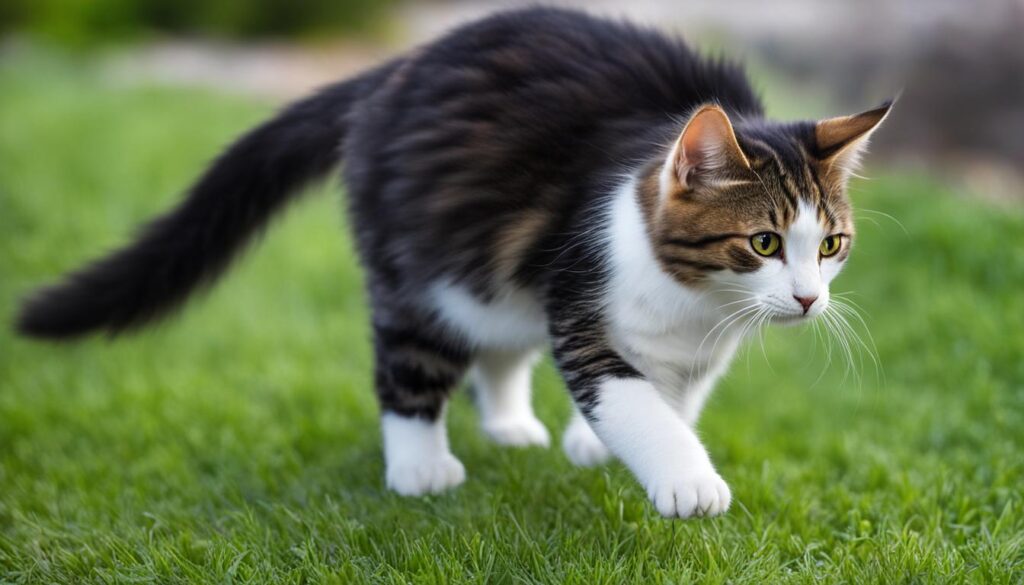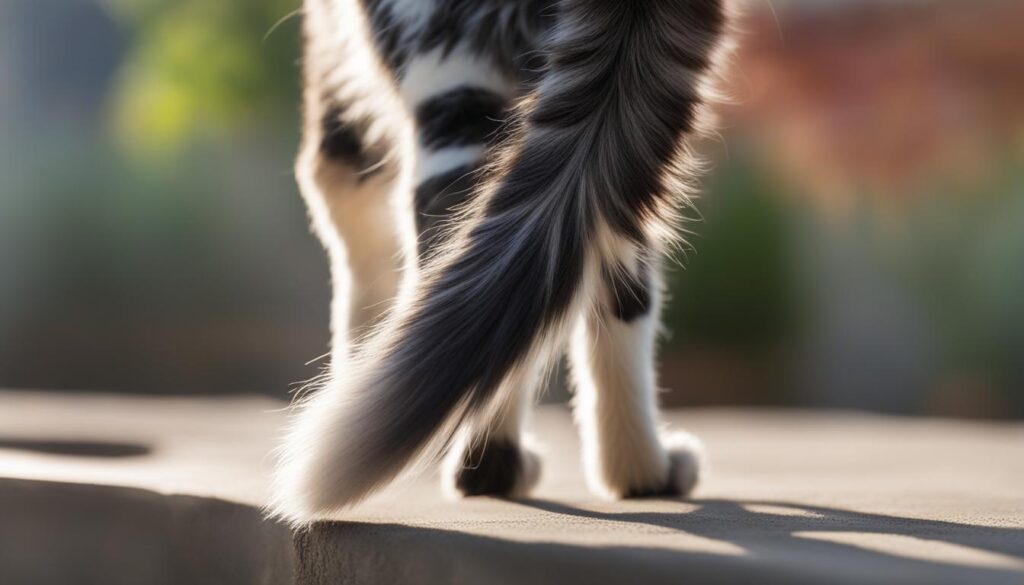Do Cats Control Their Tails? Feline Mystique Unveiled.
Cats have long fascinated us with their mysterious behavior, and one particular aspect that captivates our attention is their tail movements. It’s a common sight to see a cat’s tail flicking, curling, or standing straight up, but do cats actually have control over their tails? Let’s delve into the intriguing world of feline tail control and uncover the truth.
Key Takeaways:
- Cats have a high level of coordination and reflexes that allow them to manipulate their tails in various ways
- Cat tails serve purposes such as communication, balance, and expression of emotions
- Observing and understanding cat body language can provide insights into a cat’s emotional state and intentions
- The control of a cat’s tail is primarily governed by the nervous system
- By understanding cat body language and tail movements, we can deepen our bond with these fascinating creatures
The Basics of Cat Tail Movement
While cats may not have full conscious control over their tails, they possess a remarkable level of coordination and reflexes that enable them to manipulate their tails in various ways. The movements of a cat’s tail serve multiple purposes, including communication, balance, and the expression of emotions.
Understanding cat tail movements can provide valuable insights into their body language and help us better understand their needs and desires. By observing their tails, we can decipher their moods, intentions, and even their physical well-being.
Cat tail control is primarily achieved through the coordination of the nervous system, the spinal cord, and the muscles. Although cats may not have direct control over every individual movement of their tail, their highly reflexive nature enables them to adapt the positioning, speed, and pattern of tail movements to suit different situations.
“The tail often acts as an extension of a cat’s emotions and intentions, conveying important messages to other cats, animals, and even humans. It plays a significant role in their overall body language,” explains Dr. Emily Stevens, a veterinarian specialized in feline behavior.
For instance, a cat with a relaxed tail held in a gentle curve signifies contentment and relaxation. On the other hand, an erect and bristled tail indicates fear or aggression. A slow wagging tail often suggests curiosity or interest, while a rapid and agitated tail movement can demonstrate excitement or agitation.
By observing and interpreting these tail movements, cat owners and enthusiasts can better communicate with their feline companions, anticipate their needs, and provide a more enriched environment.
Cats’ tails are truly fascinating appendages that have captivated humans for centuries. They are not only a physical extension of a cat but also a powerful tool for communication and expression. By appreciating and understanding the basics of cat tail movement, we can further deepen our bond with these enigmatic creatures and provide them with the love and care they deserve.
Decoding Cat Body Language through Tail Movements
Cat tails can provide valuable insights into a cat’s emotional state and intentions. Understanding how do cats control their tails and why do cats move their tails can help us decipher the hidden messages they communicate through their body language. By observing and interpreting their tail movements, we can better understand and bond with our feline friends.
For instance, when a cat wags its tail, it can indicate a range of emotions such as excitement, curiosity, or even agitation. On the other hand, a puffed-up tail signifies fear or aggression, warning us to approach with caution. The positions, speeds, and patterns of tail movements play a crucial role in conveying specific messages. By paying attention to these cues, we can foster better communication and build stronger connections with our cats.
“A cat’s tail is like a window into their soul, revealing their true emotions and intentions. It’s their nonverbal way of speaking to us,” says Dr. Emily Johnson, a renowned veterinarian.
To become fluent in cat body language, it’s important to consider the context in which the tail movements occur. For example, a high, straight tail indicates confidence, while a low, tucked tail suggests submission or nervousness. A slow swaying motion can convey relaxation, while a rapidly whipping tail may signal annoyance or aggression.

| Tail Position | Meaning |
|---|---|
| High, straight tail | Confidence, alertness |
| Low, tucked tail | Submission, fear |
| Puffed-up tail | Aggression, fear |
| Wagging tail | Excitement, agitation |
| Enveloped tail | Relaxation, contentment |
Deciphering cat body language through tail movements is an essential skill for cat owners and enthusiasts alike. It allows us to understand their needs, emotions, and even potential warnings they may be trying to convey. By respecting and responding to their nonverbal cues, we can forge a deeper bond with our beloved feline companions.
The Science behind Cat Tail Control
The control of a cat’s tail is a fascinating interplay between the nervous system, spinal cord, and muscles. While cats may not have conscious control over every tail movement, their bodies possess remarkable adaptations that allow them to adjust their tail positions and communicate effectively with their surroundings.
Cat tails are comprised of multiple vertebrae, connected by muscles, tendons, and ligaments. These structures work together to provide flexibility and support, enabling cats to manipulate their tails in various ways. For example, the muscles in a cat’s tail allow it to curl, twitch, and sway, adding to the complexity of their nonverbal communication.
Interestingly, a cat’s tail movement is not solely governed by conscious thought, but rather by reflexes and instinct. The brain sends signals through the spinal cord, triggering specific muscle movements in response to external stimuli or internal sensations. This subconscious control allows cats to adapt their tails to different situations, expressing emotions or conveying intent without conscious effort.
“The nervous system plays a crucial role in a cat’s tail control, allowing them to navigate their environment and communicate nonverbally,” says Dr. Amanda Johnson, a renowned feline behavior expert. “While they may not consciously manipulate every tail movement, cats possess an innate ability to utilize their tails as an extension of their emotions.”
Through tail movements, cats can communicate a wide range of emotions, balance themselves during intricate maneuvers, and even signal their intentions to other animals or humans. For instance, a relaxed, gently swaying tail typically indicates calmness and contentment, whereas a rapidly twitching tail can indicate agitation or excitement. Cats may also fluff up their tails as a defensive display, expressing fear or aggression.
While there is still much to learn about the intricate mechanisms behind cat tail control, research and observation continue to shed light on this unique aspect of feline behavior. Understanding the science behind cat tail control allows us to appreciate the complexity of cats’ nonverbal communication and deepen our connection with these enigmatic creatures. By respecting their body language and tail movements, we can better respond to their needs and forge stronger bonds with our feline companions.

Conclusion
Cats possess a fascinating ability to control their tails, which serves as a means of communication, balance, and expression of emotions. While they may not have complete conscious control over every tail movement, their highly coordinated reflexes and instincts enable them to manipulate their tails with precision and grace. By understanding cat body language and tail movements, we can deepen our connection with these captivating creatures and better cater to their needs.
Through their tail movements, cats can convey messages to communicate with their surroundings and with other animals. A wagging tail can indicate excitement or agitation, while a puffed-up tail signals fear or aggression. The position, speed, and patterns of tail movements play a significant role in interpreting their emotions and intentions.
The control of a cat’s tail is primarily governed by its nervous system, with the spinal cord and muscles working in harmony to enable adjustments in tail position and movement. Although cats may not have conscious control over every tail flick, they possess the adaptability to respond to various situations and interact effectively with their environment.
By observing and understanding cat body language and the intricacies of feline tail movements, we can establish a stronger bond with our beloved feline companions, ensuring we provide them with the care, love, and attention they deserve. So, next time you come across a cat swishing its tail or holding it upright, take a moment to appreciate the rich and nuanced communication that lies within their elegant, tail-controlled expressions.
FAQ
Do cats have control over their tails?
While cats may not have full conscious control over their tails, they do have a high level of coordination and reflexes that allow them to manipulate their tails in various ways. Cat tails serve several purposes, including communication, balance, and expression of emotions.
What can cat tail movements tell us about their emotions?
Cat tails can provide valuable insights into a cat’s emotional state and intentions. For example, a wagging tail can indicate excitement or agitation, while a puffed-up tail signifies fear or aggression. The position, speed, and patterns of tail movements can all convey different messages.
How do cats control their tails?
The control of a cat’s tail is primarily governed by the nervous system. The spinal cord and muscles work together to allow cats to adjust their tail positions and movements. While cats may not have conscious control over every tail movement, they can adapt their tails to various situations and communicate effectively with their surroundings.
What is the role of cat tail control in communication?
Cats have a remarkable ability to control their tails to convey messages, maintain balance, and express their emotions. While they may not have full conscious control over every tail movement, their highly coordinated reflexes and instincts allow them to manipulate their tails with precision. By understanding cat body language and tail movements, we can deepen our bond with these fascinating creatures and better respond to their needs.


